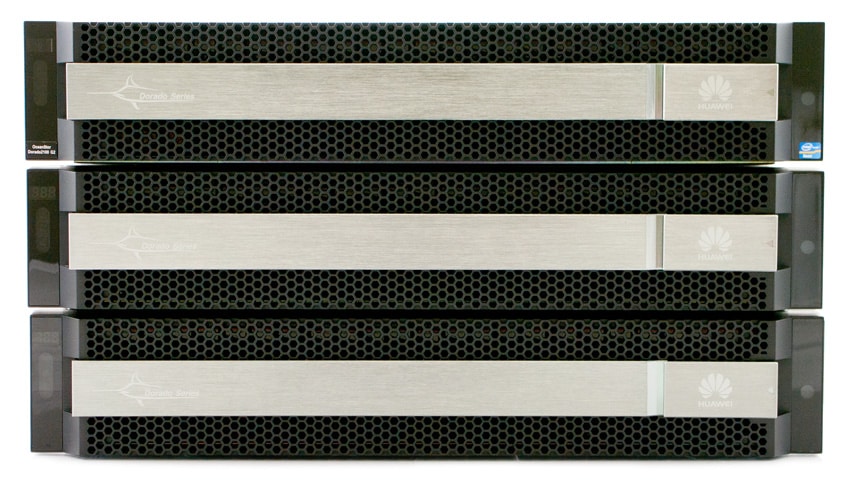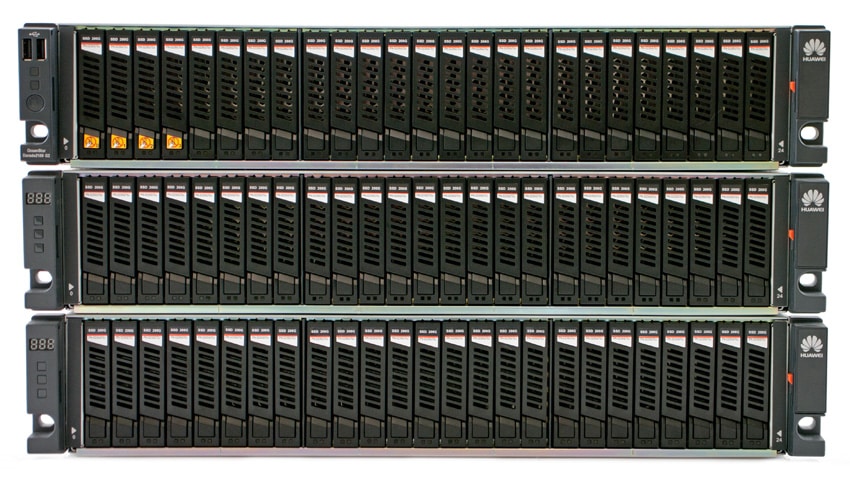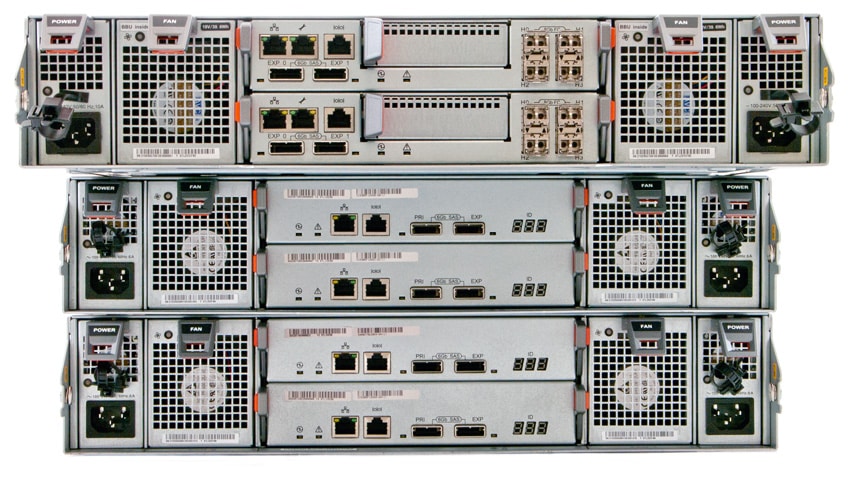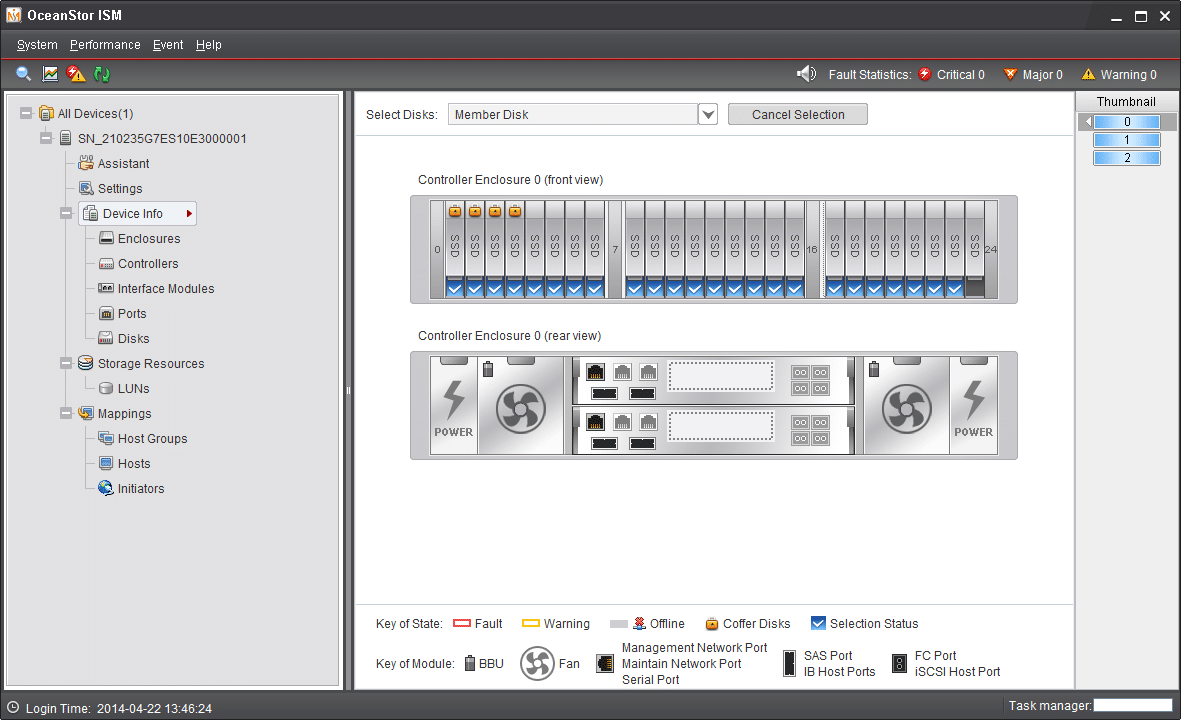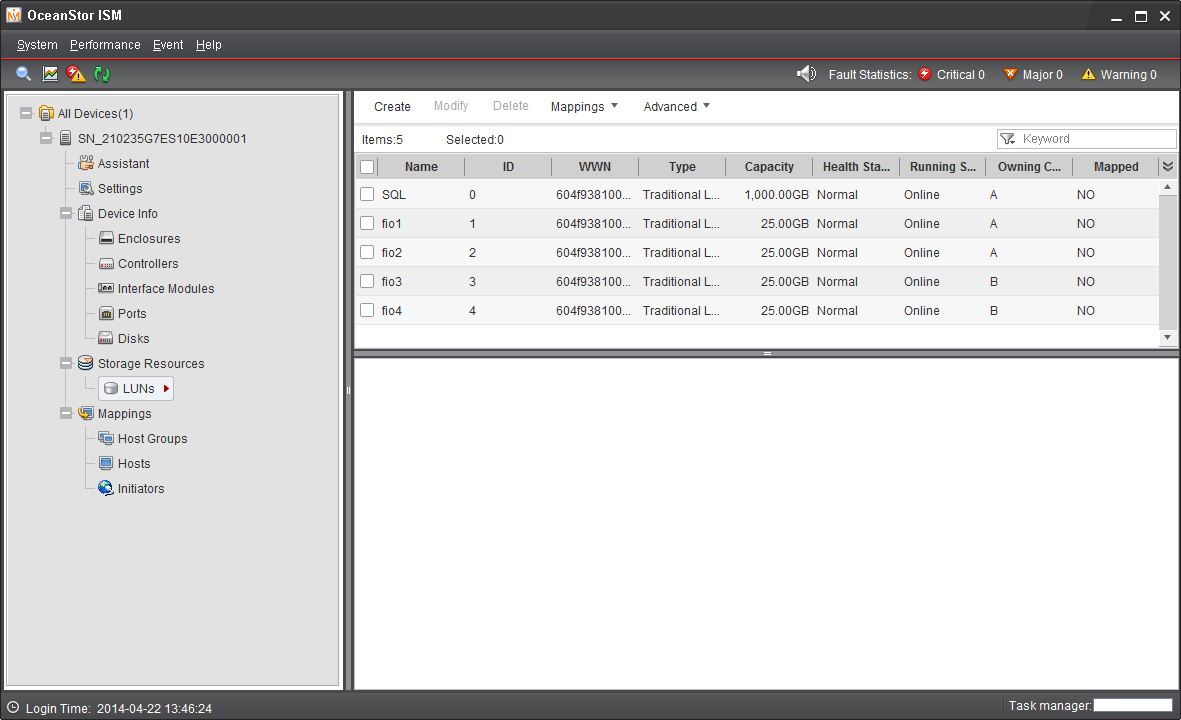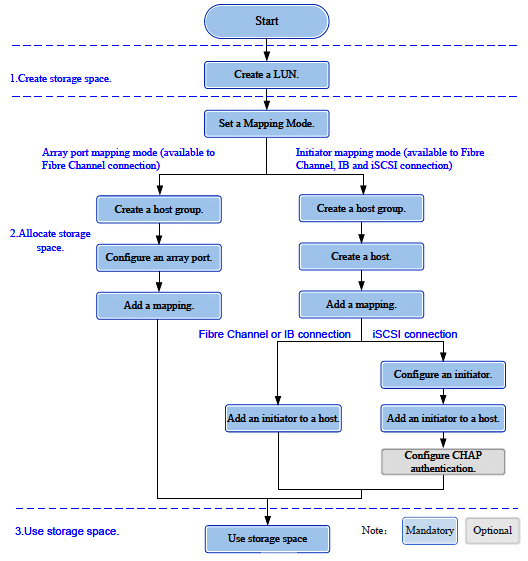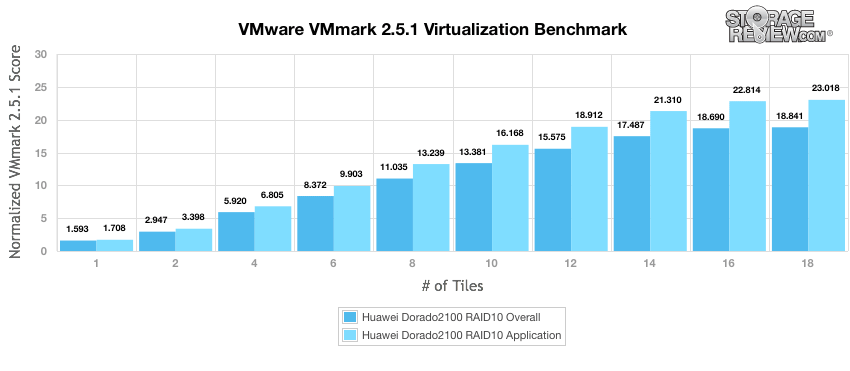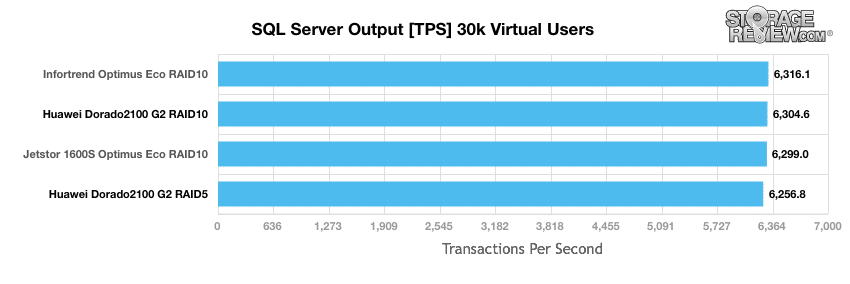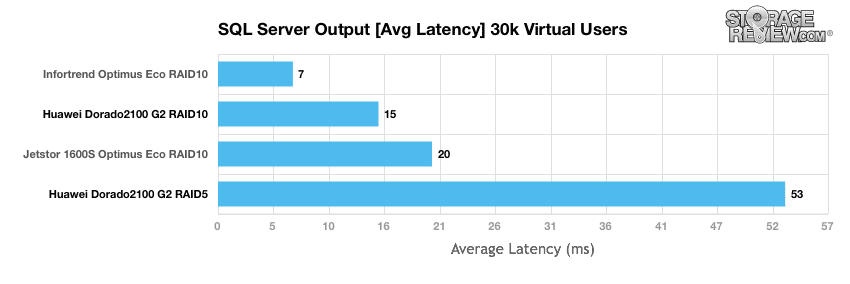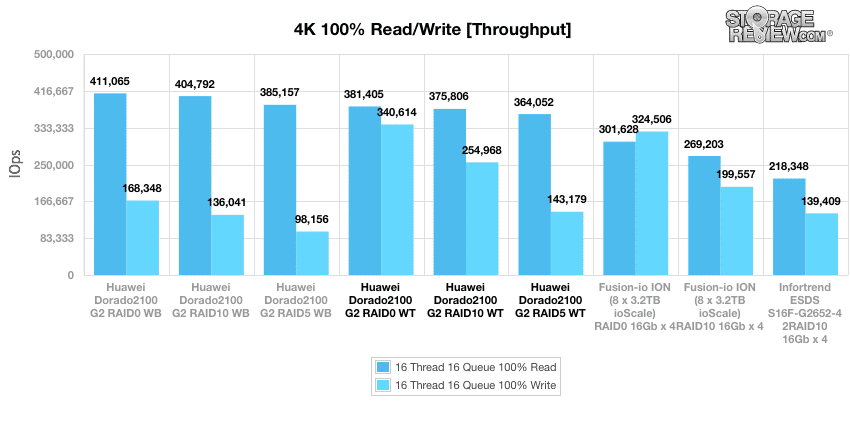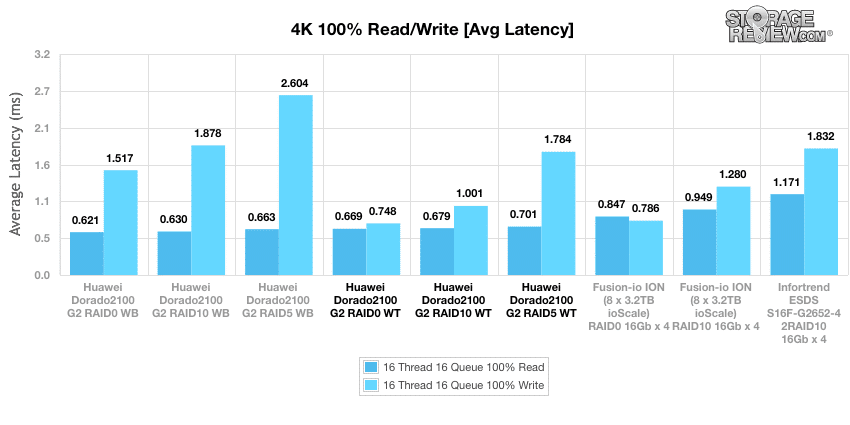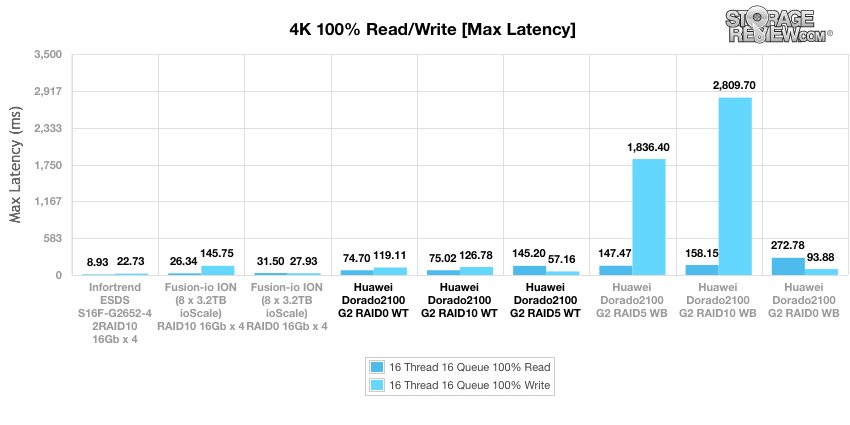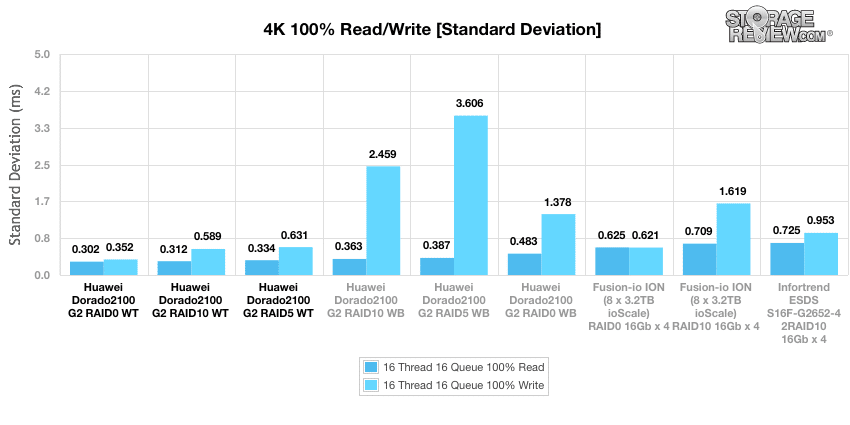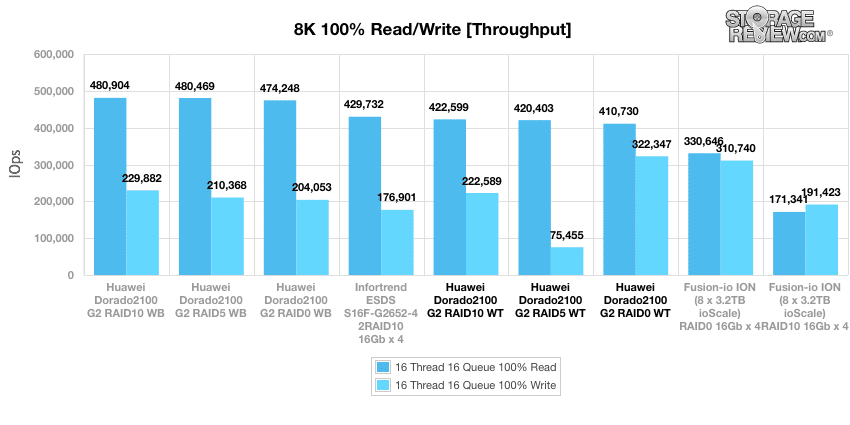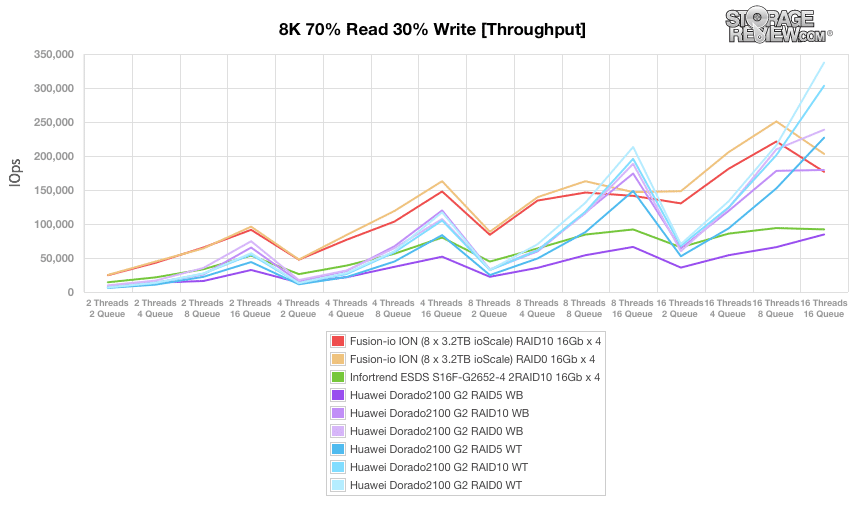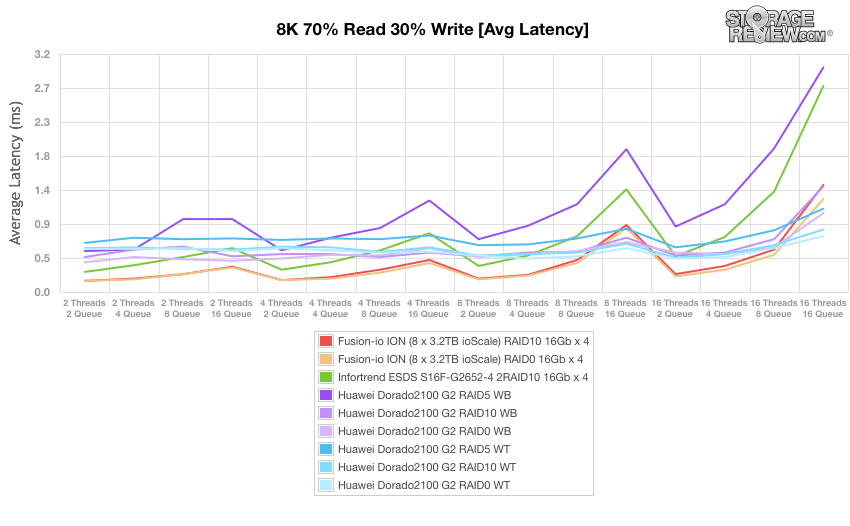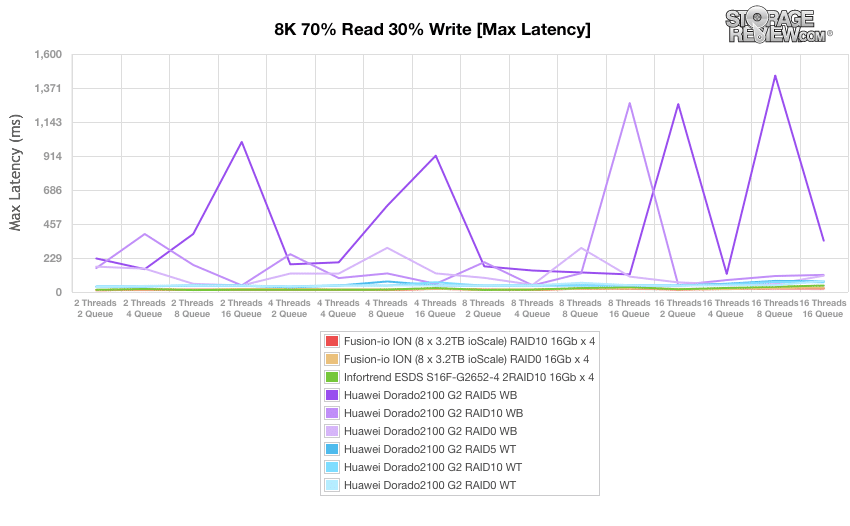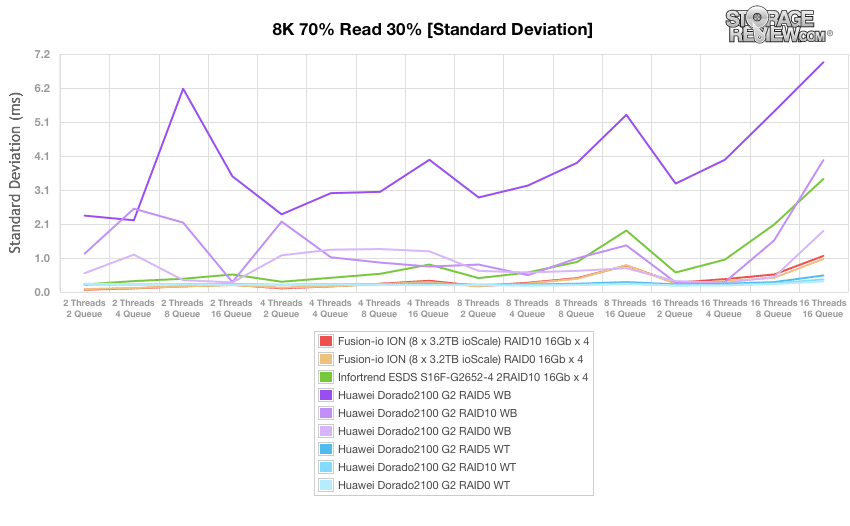
The Huawei OceanStor Dorado2100 G2 is an all-flash SAN with a dual-controller active-active architecture and configurable with either MLC or SLC SSDs. The platform is designed in house, leveraging Huawei components top to bottom, from the chassis to the SSDs and SSD controllers. This level of integration allows Huawei to push as much performance as possible from the array and is unique in the all-flash array (AFA) market. According to manufacturer benchmarks, the Dorado2100 G2 can reach 600,000 IOPS with latency down to 500μs and they also point to their public SPC-1 IOPS score of over 400k. The overall performance numbers post a gain of 3X over their first generation Dorado AFA. This level of performance makes the array ideal for high-performance database needs, VDI and other mission-critial workloads that are latency sensitive.
The Dorado2100 G2 represents a new portfolio of intellectual property at work behind the scenes but exposes a robust set of common enterprise SAN functionality including cache management, I/O scheduling, and intelligent thin provisioning. The Dorado2100 G2 is also certified for key enterprise platforms like VMware ESXi 5.1/5.0 and SAP. On the networking side, the array provides support for 8Gbit/s Fibre Channel, 10Gbit/s iSCSI, and 40Gbit/s IB QDR to enable wide support for varying use cases.
The system takes advantage of the vertical integration to use its own wear leveling, bad block repair, and random scrambling code technologies to achieve a global MTBF of greater than one million hours. Its chassis design also incorporates redundant power supplies, fans, interface modules, SSDs, and integral battery backup units. The Dorado2100 G2 supports RAID 0, 5, and 10, with global hot spares and data pre-copy for faulty drives for increased system protection.
Huawei UltraPath multipathing uses a host driver to analyze and route access between the hosts and storage devices in order to improve reliability and performance when more than one route is available to a LUN. UltraPath can be configured for failover and load balancing between servers and arrays. In addition, the Dorado2100 G2 management and maintenance mechanisms support GUI and CLI modes and provide handy alarm notifications through sound, short message, and/or by email.
Huawei provided us with a 6U test platform including the storage controller unit as well as two expansion shelves that utilize 75 200GB SLC SSDs in total.
Huawei OceanStor Dorado2100 G2 Specifications
- Enclosure: 2U for controller and each additional disk shelf
- Controllers: Dual controllers, active/active
- Onboard I/O ports: 8 x 8Gbit/s Fibre Channel
- Maximum number of I/O expansion modules: 2
- I/O expansion module options
- 4 x 8Gbit/s Fiber Channel
- 4 x 10Gbit/s iSCSI ToE (TCP offload engine)
- 2 x 40Gbit/s InfiniBand QDR
- Capacity options
- SLC: 2.5TB or 5TB per enclosure
- eMLC: 5TB or 10TB per enclosure
- Maximum expansion disk enclosures: 3
- Performance
- Bandwidth: 10GB/s
- Throughput: 600,000 IOPS
- Latency: 500μs
- Software Features
- RAID Levels: 0, 5, 10
- Maximum number of hosts: 512
- Maximum number of LUNs: 2,048
- Multipathing software: UltraPath
- Power Specifications
- Power supply (AC): 100V to 127V or 200V to 240V
- Typical power consumption
- 2U controller enclosure: 580W
- 2U disk enclosure: 295W
- Dimensions (H x W x D)
- 2U controller enclosure: 86.1mm x 446mm x 582mm (3.39in x 17.56in x 22.91in)
- 2U disk enclosure: 86.1mm x 446mm x 412mm (3.39in x 17.56in x 16.22in)
- Weight
- 2U controller enclosure with 25 HSSDs: 32.5kg
- 2U disk enclosure with 25 HSSDs: 24.5kg
- Operating environment
- 5°C to 40°C with an attitude lower than 1,800m
- 5°C to 30°C with an altitude between 1,800m and 3,000m
- Operating ambient humidity: 5% RH to 95% RH
Build and Design
The Huawei Dorado2100 G2 controller features 25 drive bays and can be connected to a maximum of three expansion shelves with 25 additional drives each. While 25 might seem like an odd number for some RAID groups such as RAID10, that 25th drive in each shelf is a dedicated hot-spare. From the front, the Dorado2100 G2 offers a minimalistic design that can hold its own against other Tier1 storage vendors.
The rear of the Dorado2100 G2 platform is modular and designed to be very easy to maintain. Each primary system component such as power supplies, fan module/battery pack, controller, or I/O module can be quickly swapped out without the use of tools. An interesting feature is the inclusion of a UPS inside the chassis to allow for system cache to flush to disk in the event of a power failure. The lithium-ion batteries are located inside each fan module, which provides ample cooling while the system is powered on.
The Dorado2100 G2 utilizes dual controllers. Each controller includes one slot for an interface module which may be Fibre Channel (8Gbit/s), iSCSI (10Gbit/s), or InfiniBand (40Gbit/s). Both controllers must utilize interfaces of the same types. Our configuration leveraged 8Gb FC, with 4 ports on each controller. Dual mini SAS cables provide connectivity between the controller and the expansion shelves with path redundancy in the event a cable fails.
Management
The Dorado2100 G2 is managed via Huawei’s ISM software, which uses a Java client for administration. A tree-based navigation pane remains at left, the right viewport for the current administrative task or a system overview. The management utility allows users to monitor the system health and handle all activities down to changing RAID type or mapping LUNs.
Viewing individual component health is an easy task through the management software, where Huawei provides a GUI interface of the array, where by hovering over certain parts pops up a window describing that component. This view can be changed to show the controller as well as each expansion shelf.
The Dorado2100 G2 supports thick “traditional” LUNs along with thin LUNs with scalable capacities. Thick LUNs cannot exceed the total capacity of the system, but thin LUNs can be provisioned with larger total amounts.
ISM supports two mapping modes: 1) initiator mapping mode which establishes mappings on the array side for Fibre Channel SANs and 2) a host-initiated array port mapping mode which is supported for all fabric types.
The ISM provides a wealth of information, including performance monitoring capabilities of the entire array down to a granular level of smaller components. This is incredibly useful when optimizing the platform in a production environment or diagnosing problems.
Testing Background and Comparables
We publish an inventory of our lab environment, an overview of the lab's networking capabilities, and other details about our testing protocols so that administrators and those responsible for equipment acquisition can fairly gauge the conditions under which we have achieved the published results. None of our reviews are paid for or overseen by the manufacturer of equipment we are testing.
We will be comparing the Huawei OceanStor Dorado2100 G2 cluster to the JetStor NAS 1600S, Fusion-io ION Accelerator, and Infortrend ESDS S16F-G2652-4.
Fusion-io ION
- Flash: 12.8TB/25.6TB usable (8 x 3.2TB ioScale PCIe SSD RAID10/RAID0)
- Network Interconnect: 4 x 16Gb Fibre Channel
Huawei OceanStor Dorado2100 G2:
- Flash: 7.2TB/14.2TB/14.4TB usable (75 x 200GB SLC Huawei SSD RAID10/RAID5/RAID0)
- Network Interconnect: 8 x 8Gb Fibre Channel
Infotrend ESDS S16F-G2652-4:
- Flash: 3.2TB usable (16 x 400GB Smart Optimus SSD RAID10)
- Network Interconnect: 4 x 16Gb Fibre Channel
Jetstor NAS 1600S
- Flash: 3.2TB usable (16 x 400GB Smart Optimus Eco SSD RAID10)
- Network Interconnect: 2 x 10GbE Twinax
Each of the comparable arrays was also benchmarked with our Lenovo ThinkServer RD630 Testbed:
- 2 x Intel Xeon E5-2690 (2.9GHz, 20MB Cache, 8-cores)
- Intel C602 Chipset
- Memory – 16GB (2 x 8GB) 1333Mhz DDR3 Registered RDIMMs
- Windows Server 2012 Standard
- Boot SSD: 100GB Micron RealSSD P400e
- 2 x Emulex LightPulse LPe16202 Gen 5 Fibre Channel (8GFC, 16GFC or 10GbE FCoE) PCIe 3.0 Dual-Port CFA
- Aggregate bandwidth: 768 Gb/s end-to-end full duplex
Our review configuration for the Dorado2100 G2 uses 75 200GB SLC SSDs, which we test in RAID0, RAID5 and RAID10.
Application Performance Analysis
Our first two benchmarks are the VMware VMmark Virtualization Benchmark and the Microsoft SQL Server OLTP Benchmark which both simulate application workloads similar to those which the Dorado2100 G2 and its comparables are designed to serve.
The StorageReview VMmark protocol utilizes an array of sub-tests based on common virtualization workloads and administrative tasks with results measured using a tile-based unit. Tiles measure the ability of the system to perform a variety of virtual workloads such as cloning and deploying of VMs, automatic VM load balancing across a datacenter, VM live migration (vMotion) and dynamic datastore relocation (storage vMotion).
The highest normalized Dorado2100 G2 VMmark 2.5.1 application score was 23.02 with 18 Tiles, while its highest overall VMmark score was 18.84 at 18 Tiles. At one tile, the normalized application score was 1.71 while the one-tile overall score was 1.59. It should be noted that this is the highest performance we've measured in VMmark to date. Our testing cluster ran out of steam before I/O latency picked up from the array!
StorageReview’s Microsoft SQL Server OLTP testing protocol employs the current draft of the Transaction Processing Performance Council’s Benchmark C (TPC-C), an online transaction processing benchmark that simulates the activities found in complex application environments. The TPC-C benchmark comes closer than synthetic performance benchmarks to gauging the performance strengths and bottlenecks of storage infrastructure in database environments. Our SQL Server protocol uses a 685GB (3,000 scale) SQL Server database and measures the transactional performance and latency under a load of 30,000 virtual users.
In this benchmark we leveraged write-back cache on all three arrays and used a single 1TB iSCSI or FC to present to our SQL Server to place its database under test on.
In terms of transactions per second, the Dorado2100 G2 is near the top of our measured values during the SQL server test with both RAID configuration. These results reflect a competent performance limited only by the environment and testing protocol.
The more significant result for the SQL Server benchmark is our measurement of average latency which is more reflective of the way performance is experienced by a database system's users and administrators. With a workload of 30,000 virtual users and configured for RAID10, the Dorado2100 G2 kept average latency to 15ms, ahead of the Jetstor 1600S. Reconfigured for RAID5 to offer higher capacity, the Dorado clocked average latency at 53ms.
Synthetic Workload Analysis
Our synthetic benchmark protocols each begin by preconditioning the target storage into steady-state with the same workload that will be used to test the device. The preconditioning process uses a heavy load of 16 threads with an outstanding queue of 16 per thread.
Preconditioning and Primary Steady-State Tests:
- Throughput (Read+Write IOPS Aggregate)
- Average Latency (Read+Write Latency Averaged Together)
- Max Latency (Peak Read or Write Latency)
- Latency Standard Deviation (Read+Write Standard Deviation Averaged Together)
Once preconditioning is complete, each device being compared is then tested across multiple thread/queue depth profiles to show performance under light and heavy usage. The synthetic workload analysis for this review will use two profiles which are widely referenced among manufacturer specifications and benchmarks:
- 4k Profile
- 100% Read and 100% Write
- 8K Profile
- 100% Read and 100% Write
- 70% Read, 30% Write
During these synthetic benchmarks, we tested the Dorado2100 G2 in two modes: WB, which denotes write-back cache is enabled, and WT, which denotes write through. Write back sends data through the controller cache, which improves response times for burst transfers. Write through sends data directly to the SSDs and therefore should have higher performance with constant workloads.
During the 4k synthetic benchmark, the Dordo2100 G2 achieved the greatest read throughput among the comparables with write back enabled. Although switching to write through reduced the read throughput slightly, it made a big improvement write throughput. The Dorado2100 G2 achieved its best overall performance in the 4k benchmark when configured as a RAID0 array with write through enabled, at 381,405 IOPS for read operations and 340,614 IOPS for write operations.
Enabling write through also makes a key difference for the Dorado2100 G2's write latencies during the 4k synthetic benchmark. The Dorado2100 G2's average 4k write latency as a RAID0 array with write back enabled is 1.52ms. Write through mode averages less than half that latency at 0.67ms with a RAID0 array.
Maximum latency during the 4k benchmark is a metric where the Dorado2100 G2 falls behind the comparables across each of the configurations we tested. As with the other 4k results, write performance did improve when write through was enabled
Standard deviation results help identify devices which experience a greater than average range of latencies during the synthetic benchmark. During the 4k benchmark, the Dorado2100 G2 achieved best-in-class standard deviation results while configured for write through mode.
After reconditioning the arrays for 8k workloads, we measured the throughput of the comparables with a heavy load of 16 threads and a queue depth of 16 for 100% read and 100% write operations. With these workloads, write back mode provided the best overall 8k performance for the Dorado2100 G2 except when the array was configured for RAID0.
The next results are based on a test composed of 70% read operations and 30% write operations with an 8k workload across a range of thread and queue counts. The Dorado 2100 G2 had its best showing on workloads with high thread counts and high queue depths, where it was often able to outperform the Fusion-io configurations which otherwise took top position. The Dorado 2100 G2 performed better overall during the 8k 70/30 benchmark when configured for write through.
In terms of average latency, the Dorado2100 G2 also performed best with higher workloads during the 8k 70/30 benchmark and benefited most from the write through configuration. The worst results for the Dorado2100 G2 during this benchmark came during the RAID5 test.
The highest latencies for the Dorado2100 G2 during the 8k 70/30 benchmark were measured when the system was configured in write back mode and peaked with large queues. Maximum latencies for the Dorado2100 G2's write through configuration were much lower but still higher than the comparable arrays.
Standard deviation calculations for the 8k 70/30 benchmark also highlights trouble the Dorado2100 G2's write back configuration had with this workload at high queue counts. On the other hand, the write through configuration was able to achieve latencies which were more consistent than the comparables. At a thread count of 16 and a queue depth of 16, the Dorado2100 G2 configured for RAID0 and write through kept its standard deviation to 0.32ms.
Conclusion
The Huawei Oceanstor Dorado2100 G2 is an ultra high-performance all-flash array designed to act as primary storage for I/O intensive application workloads. With expansive vertically-integrated configurations offered with either MLC or SLC flash, the Dorado2100 G2 is designed for growing datacenters with heavily virtualized infrastructure, large databases or high-performance compute needs. Huawei positions the flash array with a wide featureset, as well as multiple interconnect options including 8Gb FC, 10Gb iSCSI as well as 40Gb IB. This gives it the flexibility to work across different market segments that leverage different storage network fabrics. In terms of performance, the platform is aimed to replace large traditional HDD SANs, providing significant power savings when you factor that a 2-8U array is designed to out-perform a 1,500 15K HDD SAN.
In terms of performance, the Oceanstor Dorado2100 G2 posted exceptional results across the board, setting records across many of our array benchmarks. In our 4k random 100% read and 100% write profile, it showed the greatest read throughput among the comparables with write back (WB) enabled, boasting 411,065 IOPS in RAID0. With write through (WT), read throughput disparity wasn’t significant; however, its write speed more than tripled in some cases. The Dorado2100 G2 also performed very well in average latency with WB enabled, though its write latency was significantly higher compared when WT was used. In our 8k sequential (100% read and 100% write) workload, Dorado2100 G2 was the top performer in write back mode provided, particularly when the array was configured for RAID10, boasting 480,904 IOPS read at 16T/16Q. When looking at our test composed of 70% read operations and 30% write operations with an 8k workload across a range of thread and queue counts, the Dorado2100 G2 posted its results (as well as being at the top of the leader board by a significant margin) when configured in RAID0 WT.
While synthetic results show a good starting point, we were most impressed with its strong performance in our application tests. In SQL Server testing the Dorado2100 G2’s average latency was 15ms. In our VMware VMmark benchmark, the Dorado2100 G2 took our 4-node top-spec compute cluster to its limits, pushing its peak load up to 18 tiles while still keeping QoS in check. It had the highest recorded VMmark run in our lab to date, by a significant margin. To say these numbers are impressive is an understatement.
If Huawei is going to get knocked much, it's on the data services side. While they do have multipathing drivers and features like thin provisioning, the units are missing core functionality like system-wide snapshots, replication and data reduction (dedupe and compression), though some of their larger AFA systems do include additional services. The data reduction features are especially important in AFAs as the raw vs usable debate is one that weighs heavy in the buying decision process. Huawei counters this some by being more cost effective than many other AFAs though and they have some advantages others don't like a support advantage from being vertically integrated and hardware that is dedicated to this job with features like the integral battery backup unit. For application-defined workloads the Dorado2100 G2 has a lot to offer, standing out as unique in a crowded market.
Pros
- Strong overall benchmark results across the board
- VMmark benchmarking results set new performance standard in our lab
- Intuitive management interface
- Vertically integrated, dedicated system design
Cons
- Poor latency results for some workloads in write back mode
- Lacks some data services that competing systems offer
The Bottom Line
The Huawei Dorado2100 G2 is a versatile and competitive all-flash array that boasts top-in-class performance in many of our benchmarks, while still being relatively cost-effective in the increasingly crowded AFA market.

